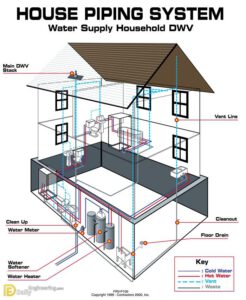How Does Your House Plumbing Work?
Your household plumbing is responsible for bringing in fresh water and draining away waste. It’s easy to take this vital service for granted – until something goes wrong.
Woodland Hills Plumber supplies water to faucets, fixtures, and appliances throughout a house. The system also carries away wastewater and keeps the pipes from becoming clogged. It’s a complex network that can seem mysterious and magical, but it operates according to some basic laws of nature. Understanding how the system works can help you spot and fix potential problems before they become serious.

The first step in understanding your home’s plumbing is to understand where the fresh water comes from and where it goes after you use it. Your plumbing system is comprised of two separate subsystems that don’t intersect: the supply system and the drainage system. The supply system brings in municipal or private water from a water tower, lake or river and distributes it throughout your home; the drainage system takes away wastewater and sends it to the sewer or septic tank.
Your home’s water supply system starts with the main line, which connects to your water meter. From there, a system of plastic, iron or copper pipes carries fresh water to your water heater and from there to every fixture in the house that requires it. Some of those pipes are hot-water lines that run to your showers and toilets; others carry cold water for sinks, washing machines and dishwashers. The water is under pressure in this system, which helps it travel long distances and reach the highest and lowest parts of your home.
A pressure-reducing valve, located on the main line near your water meter, reduces the high pressure from the city water supply to a safer level for your home’s plumbing. This prevents the pipes from bursting and damaging your home, and it ensures that your water pressure is sufficient for all of your household uses.
Your drainage system consists of all the drains in your home, including those in your kitchen, bathrooms and basements. These drains transport sewage and waste water through a system of horizontal branch pipes hidden in the walls and floors, which connect to soil stacks, which take the waste to the septic or sewer tank. A home plumbing system also includes traps, which prevent backflow of sewage and other contaminants.
A modern home can’t function without plumbing – it would be impossible to have running water for drinking, washing or flushing toilets. But how does it all work? It’s a complicated network of pipes that involves drainpipes, vent pipes and water supply pipes. And the plumbing system is one of the most expensive parts of a home to repair or install, so it pays to understand how it works.
Water comes into your house from the water mains and flows into a water storage tank or directly to appliances like water heaters and hot water tanks. From here, it’s pumped around your house by the pressure of water systems pipes. This is done by the water service lines, which are usually buried underground. Some homes have their own water tower or tank to supply freshwater, while others get their supplies from a municipal water supplier.
The water is distributed in your home through the water supply pipes, which are usually made of copper, galvanized iron or plastics. They run throughout the house and connect to each faucet. Most have valves and fittings to control the flow of water. The valves are generally quarter-turn and can be turned off easily to allow for maintenance or repairs on individual fixtures. A water meter is installed to measure the amount of water that enters your home. A pressure-reducing valve is often installed to lower the high water pressure from the mains to a safe level for your household, because overly high pressure can damage pipes and fixtures.
In newer homes, separate water lines run to each fixture, so that the use of water in one room does not affect the use of water in another. For example, a kitchen sink may have its own line to the water heater and a separate cold water line. This ensures that you always have enough water for cooking, cleaning and drinking, even if the rest of the house is using water.
The drainage and waste-vent system carries away the sewage, wastewater and dirty water from toilets, showers, drains and sinks into either the public sewer or septic tank, depending on how your home is designed. This is also a critical part of your home’s water conservation, as efficient plumbing practices reduce the waste of this valuable resource.
The home plumbing system is all about delivering water to the places we use it and getting rid of wastewater. This is why it’s important to understand how the drainage system works. Being familiar with the parts and components of a drain will help you better troubleshoot when something goes wrong and make quick fixes without calling in a professional.
Every time you use the shower, sink or toilet, freshwater enters the fixture and wastewater leaves through the drain. The drain-waste-vent (DWV) system, which is a series of downward angled pipes, is charged with transporting this wastewater away from the house. Like the supply system, it’s not pressurized, so it relies on gravity to push waste down the pipes and into the municipal sewer line.
Immediately after each fixture drain, there’s a U- or P-shaped section of pipe known as the trap. This holds standing water to prevent sewage gasses from rising up into the home. This is mandated by state and local plumbing codes for all homes. If you don’t keep up with regular maintenance, these traps can dry out and let sewer odors into the home. Simply pouring some water down the drain will fill the trap and eliminate foul odors.
From the fixture drains, horizontal branch drain lines run down the walls to soil stacks, which connect to the main sewer line. There are vents along the way to allow air to flow through the pipes, preventing them from becoming too tightly packed with solid materials.
The final segment of the DWV system is the main sewer line, which connects to the municipal sewer or septic tank. It’s not as complex as the piping in your home, but it’s still a critical piece of infrastructure that deserves our attention and care.
One of the most common causes of blockages is misconnecting drains. Be sure that all of your drains are properly connected and aren’t obstructed by hair, soap scum or other debris. Also, be sure to only flush toilet paper down the toilet and avoid dumping cooking fat or oil down the kitchen sink. This can lead to major problems down the road.
Your plumbing system doesn’t just supply clean water; it also disposes of waste. Every fixture that uses fresh water has a drain, and the waste it produces goes down these pipes into the sewer system or septic tank. The main waste and vent pipe (also known as the sewer line) slopes downward away from your house and connects to the city’s sewage main line.
If your home is connected to a public sewer system, the wastewater that flows out of your toilets, bathtubs and showers, sinks and washing machines enters the main line at the same time. The force of gravity causes wastewater to flow downhill and out of the drains, where it joins with the sewage from other homes until it reaches the city’s treatment plant.
The sewage system treats wastewater in three basic steps: primary, secondary and tertiary. Each step removes harmful substances from the water and helps make it safer for the environment and people.
In a residential sewer system, the waste from toilets and other fixtures travels through a network of pipes to the septic tank or a community sewer system. The sewage moves to the tank and settles in layers, with solid wastes settling at the bottom and liquids like grease floating on top.
After a period of time, the septic tank is empty and the liquid sewage is released into a drainfield for further treatment in the soil. Most households in the United States use individual septic systems to treat wastewater instead of public sewers. These are more affordable and environmentally friendly, but they still require regular maintenance by certified septic plumbers to avoid costly repairs.
Keeping the drains and pipes in your household working properly is important for the health and comfort of your family. You can do your part by using only toilet paper and by disposing of food waste in the garbage, not down the drain. Remember that flushing napkins, tampons and other trash can cause blockages in the drainage system that will need to be cleared by a professional septic repair plumber.

